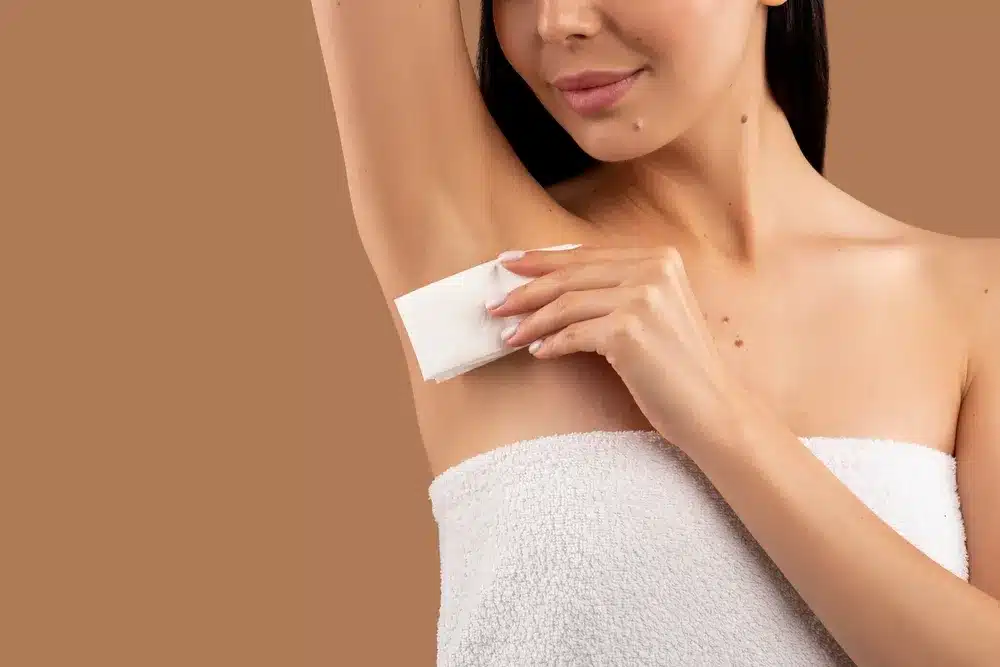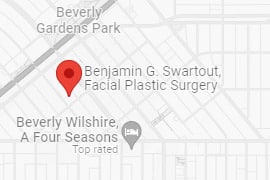Hyperhidrosis is a medical condition where a person sweats more than necessary, often leading to discomfort and embarrassment. Botox, well-known for treating facial lines, is also a solution for managing hyperhidrosis. Dr. Benjamin G. Swartout, an expert in the field, explains how Botox can help reduce the symptoms of this condition.
Dr. Swartout provides insight into the process, from the first appointment to follow-up care after treatment. He emphasizes the importance of a thorough approach to help those with hyperhidrosis manage their excessive sweating and improve their quality of life.

Key Takeaways Section
- Botox injections can effectively reduce excessive sweating by temporarily blocking the sweat glands.
- Treatment with Botox is suitable for underarms, hands, and feet, where hyperhidrosis is often most severe.
- The effects of Botox for hyperhidrosis last about 6 to 12 months, after which additional treatments may be needed.
- Patients usually notice a significant decrease in sweating within 2 to 4 days after receiving Botox injections.
- Before opting for Botox, it’s important to discuss potential side effects and suitability with a healthcare professional.
Understanding Hyperhidrosis and Botox as a Solution
Hyperhidrosis is a condition where people sweat excessively, way more than what’s needed to cool the body down. This can make day-to-day activities and social life quite challenging, pushing those affected to seek out effective solutions.
Among various options, botulinum toxin products, particularly botulinum toxin type, stand out. By injecting Botox into the sweaty areas, it temporarily stops the nerves that trigger sweating. This approach doesn’t just cut down on excessive sweating but also markedly boosts the quality of life for individuals dealing with hyperhidrosis.
Turning to Botox for hyperhidrosis treatments reflects the product’s wide-ranging use, not just in beauty but in providing a much-needed remedy for those suffering from this condition.
The Importance of Treating Excessive Sweating
Treating excessive sweating, or hyperhidrosis, is about more than just dealing with discomfort. It significantly impacts an individual’s quality of life. Excessive underarm sweating can cause visible sweat marks, leading to feelings of embarrassment in social situations. This condition can harm one’s emotional health and confidence.
Treatment for hyperhidrosis, like Botox, provides a solution. Once excessive sweating decreases, people often find it easier to engage in social interactions and feel more comfortable in their daily lives. Managing severe underarm sweating is important not just for the physical relief it offers but for improving mental well-being too. It plays a key role in helping individuals regain their confidence and enjoy a more satisfying life.
Step 1: Consult with a Healthcare Professional
Determining Your Eligibility for Botox Treatment
It’s essential to talk to a healthcare professional to see if you’re a good fit for using toxin for hyperhidrosis. They will look into your medical history to make sure injections of botulinum toxin are safe for you. This check is critical to understand how your body’s fight-or-flight response might affect your hyperhidrosis and to figure out if Botox can help you manage it.
Understanding the Risks and Benefits
Botox is an effective option for controlling excessive sweating, but it’s crucial to discuss the possible adverse reactions and benefits with your doctor. Side effects can happen but are rare, including injection-site pain and feeling tired, which highlights the importance of professional guidance. Your doctor will explain how Botox works as a medicine that temporarily stops sweating in targeted areas, providing relief. Discussing these aspects with a healthcare provider helps you make a well-informed choice, setting realistic expectations for the results.
Step 2: Preparing for Your Botox Appointment
What to Do Before Your Treatment Session
Before your botulinum toxin injection, it’s essential to avoid some medicines that might increase the risk of bruising. Discussing your medical history with your provider is crucial to ensure botulinum toxin preparation is suitable for you.
Keep yourself hydrated and tell your specialist about any issues with your skin near the area to be treated. Also, try to stay out of the sun to keep your skin in good shape.
Commonly Questions Before Treatment
- What can I expect during the injection of botulinum toxin? The process involves a quick pinch when the needle goes into the muscles, but it shouldn’t be too uncomfortable.
- How should I care for my skin afterward? It’s best not to touch the treated area or put any pressure on it. This helps the botulinum toxin stay where it’s supposed to. You might have some mild pain or swelling, but this should go away quickly.
- Will my daily activities be affected? You should be able to get back to your day right away but save any heavy workouts for later.

Secure Your Safe Procedure Experience with Dr. Swartout
Join our satisfied clients who’ve experienced safe, effective treatments.
Step 3: The Botox Treatment Process
What Happens During the Procedure
The procedure begins by pinpointing the areas where hyperhidrosis impacts you the most. We then numb these spots with a topical numbing agent to lessen any discomfort. Next, small quantities of botulinum toxin products are carefully injected into the affected area. These injections aim at the muscles that activate sweat production, significantly reducing their activity. You might experience some injection-site pain during this, but it’s usually minor.
Immediate Aftercare Instructions
Right after the procedure, it’s important to follow some aftercare steps to get the best and immediate long-term results, while also lowering the chance of experiencing adverse reactions. You should avoid touching or pressing on the treated spots to stop the botulinum toxin from moving to nearby muscles. It’s common to have some injection-site pain or even some bruising, but these symptoms go away on their own pretty quickly. Applying cold packs can help relieve any discomfort. Staying hydrated is also beneficial for your recovery. Most crucially, keep an eye on the treated area for any adverse reactions like swelling or itching, and let us know if you notice anything. With the right care, you’ll start seeing the benefits of the treatment, enjoying a significant reduction in excessive sweating.
Step 4: Post-Treatment Care and Monitoring
Managing Expectations: Immediate and Long-Term Results
After a Botox treatment, it’s important to know what to expect both immediately and over time. Most patients begin to notice a decrease in sweating within a few days, with the full effects typically becoming apparent after about two weeks. The results of the treatment, aimed at reducing sweat production, tend to last around 6 months. At that point, you may require another session to maintain dryness. It’s also key to be vigilant for any adverse reactions, like muscle weakness, though such side effects are uncommon.
Follow-Up Visits and Touch-Up Treatments
Scheduling follow-up visits is crucial for monitoring the treatment’s effectiveness and determining the need for touch-up treatments. These check-ups help the healthcare provider assess for any adverse reactions and administer additional injections if sweating persists in certain areas. Although many individuals experience a significant reduction in sweating after just one treatment, some may require subsequent sessions to achieve optimal results.
Additional Advice on Managing Hyperhidrosis
Lifestyle Modifications and Home Remedies
For those dealing with excessive sweating, making some changes in daily habits can really help:
- Wear clothes made of breathable fabrics to allow air circulation.
- Apply antiperspirant more effectively to targeted areas to control sweating.
- Keep your surroundings cool to minimize the effects of sweat.
- Consider over-the-counter antiperspirants designed for an excessive sweating patient.
- Use natural substances like witch hazel for their drying effects.
When to Consider Alternative Treatments
If lifestyle modifications and medical treatments haven’t fully addressed your sweating issues, exploring alternative treatments is advisable. Techniques such as:
- Iontophoresis: employs a mild electrical current through water to reach your skin.
- Anticholinergic drugs: help reduce sweating.
It’s crucial to consult with a healthcare professional to determine the most appropriate option for your condition.
Precautions and Possible Side Effects of Botox for Hyperhidrosis
Recognizing and Addressing Complications
When using Botox to treat hyperhidrosis, it’s important to know about the possible side effects. People often report adverse reactions such as pain where the injection was given, infection, flu-like symptoms, and muscle weakness. The botulinum toxin injection is given through small cuts to keep any visible signs to a minimum. But, it’s crucial to watch out for botulinum toxin effects that might show up in areas beyond where you were treated. This could be a sign of a more serious problem.
Tips for Reducing Side Effects
You can lessen the chance of undesirable effects from Botox for hyperhidrosis by taking a few precautions:
- Choosing a qualified provider: An expert who is well-versed in the specific areas for injection can treat your condition without unnecessary risks.
- Follow post-procedure care instructions: Listening to your provider’s guidance on what to do after the procedure can help avoid infection and other complications.
- Inform your doctor of all medications and supplements: It’s crucial to tell your doctor about any other medications or supplements you’re taking, as some can make bleeding more likely or interact badly with the botulinum toxin.
Keeping informed about toxin effects and following these pieces of advice can help you see improvements in your hyperhidrosis while keeping the risk of adverse reactions low.
Summary and Expected Outcomes of Botox Treatment for Hyperhidrosis
Botox treatments serve as an ideal treatment for helping individuals with excessive sweating due to hyperhidrosis. This method uses injections of botulinum toxin to target and temporarily block the nerves responsible for stimulating sweating.
As a result, patients often see a noticeable decrease in sweating, which enhances their comfort and overall quality of life.
While the treatment of hyperhidrosis with Botox shows promising outcomes, it’s possible to encounter some adverse reactions. Most adverse reactions are generally mild and don’t last long.
Anyone considering this option should have a detailed conversation with their healthcare provider about potential side effects before starting the treatment.
If you’re thinking about Botox for excessive sweating, it’s important to talk to someone who knows a lot about it. Dr. Benjamin G. Swartout in Los Angeles, CA, is a skilled facial plastic surgeon with a lot of experience. He’s good at surgeries that help you look and feel better. Dr. Swartout is also well-known for his natural-looking nose jobs.
He uses his expertise to help people with excessive sweating. Talk to Dr. Swartout to learn how Botox can help you. He will create a treatment plan just for you. Schedule a consultation with Dr. Swartout to see how Botox can help you stop sweating too much.

